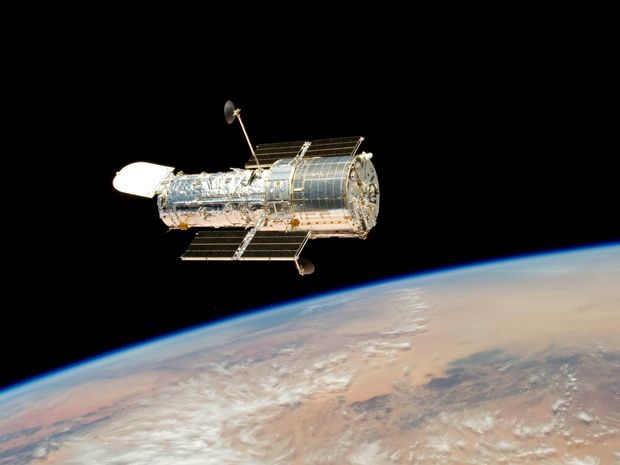Happy Birthday Hubble!
After 25 years and a tumultuous life, Hubble is still going strong
Launched 25 years ago today, the Hubble Space Telescope (HST), or simply “the Hubble,” became the world’s eye on the universe, delivering to astronomers and the general public an endless stream of images with unsurpassed clarity.
Many revolutions in astronomy have been tied to specific telescopes and their uers, from the tiny telescope with which Galileo proved that the Earth revolved around the Sun and discovered the moons of Jupiter, the Leviathan of Parsonstown, used to by the 3rd Earl of Rosse to discover the spiral structure of what are now known as galaxies, and the 2.5-meter Hooker Telescope used by Edwin Hubble during the 1920s to measure the expansion of the Universe itself. And over the last quarter century, the HST has kept up this noble tradition.
Although the Hubble’s mirror, with a diameter of 2.4 meters, is smaller than the mirror of even the Hooker telescope, it’s location in orbit above the Earth’s distorting atmosphere and the use of state-of-the-art CCD image sensors has helped to pin down the age of the Universe, determine the existence and distribution of dark matter and dark energy, and probe the atmosphere of planets in distant star systems.
The Hubble’s succesfull run owes a lot to the Space Shuttle fleet, which was used to launch the Hubble and service it several times. Shortly after the Hubble was sent aloft in 1990, it was discovered that its main mirror had a manufacturing error that caused it focus light incorrectly (The error was ultimately traced to a spot of non-relective coating flaking off in an optical instrument used to measure the shape of the mirror). In 1993 a Space Shuttle crew was able to install corrective optics restoring the full definition of the telescope.
Subsequently, during four more Shuttle missions, astronauts performed repairs and replaced or updated electronics, gyroscopes, and instruments. New CCD sensors installed during the 1999 servicing mission doubled the definition of the images it sent back to Earth.
“The telescope was supposed originally to work something like ten years, and it became fifteen, twenty, and now it is twenty five and still going strong. Not only have we achieved everything that we wanted to achieve, but many many more things that we couldn't even have imagined,” said Mario Livio, an astrophysicist at the Space Telescope Science Institute in Baltimore, Maryland, in a recent interview by the BBC.
Here are just a few of the significant discoveries Hubble has sussed out in its 25 years:
The Age of the Universe
Astronomers measure the distance of galaxies by observing cepheids, a type of variable stars in which the brightness is related to the period of their brightness variations. Because of its sensitivity, the Hubble is able to observe cepheids in very distant galaxies, millions of light years away. By calculating how long these galaxies have taken to reach the measured distances, starting from the Big Bang, they helped establish the age of the Universe, 13.7 billion years.
Dark Energy
Besides cepheids, supernovae can also serve as distance indicators, and because they are much brighter than cepheids, they can be observed over enormous distances. Images of supernovae in very distant galaxies provided by Hubble showed that their apparent brightness was too low to be at the distance of these galaxies inferred by the red shift alone. So their distance showed that the expansion of the universe is speeding up. Why this happens is still an open question. It has to be caused by a yet unknown force, called dark energy.
Dark Matter
Dark matter is not visible by itself, but its effects can be identified in images taken by the Hubble and other ground-based telescopes: the dark matter in galactic clusters deforms the apparant shape of distant galaxies behind it by bending the light coming from them into arcs. Known as gravitational lensing, this allows the location of dark matter clouds to be established.
Exoplanet Atmospheres
The discovery of numerous exoplanets, planets that circle stars other than the Sun, has given rise to the speculation that many planets with atmospheres and temperatures to Earth's might exist and would harbor life. That one could actually analyze the composition of the atmospheres of such planets was one of the unexpected achievements of the telescope. In 2013 the Hubble succeeded in detecting small amounts of water in the infrared spectra of five planets while they were passing in front of the stars they are circling.
NASA expects that the Hubble could go on until at least 2020. The James Webb Space Telescope, Hubble’s successor, will be launched in 2018.
